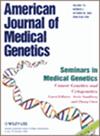Note from the editors
IF 2.8
3区 医学
Q2 GENETICS & HEREDITY
American Journal of Medical Genetics Part C: Seminars in Medical Genetics
Pub Date : 2023-03-23
DOI:10.1002/ajmg.c.32039
引用次数: 0
Abstract
This special issue, Gene-Targeted Therapies: Early Diagnosis and Equitable Delivery, is the result of a workshop held in June 2021 by the National Institutes of Health (NIH), led by the National Center for Advancing Translational Sciences (NCATS), in conjunction with the Eunice Kennedy Shriver National Institute of Child Health and Human Development (NICHD) and the National Institute of Neurological Disorders and Stroke (NINDS), entitled, “Gene-Targeted Therapies: Early Diagnosis and Equitable Delivery” (GTT-EDED; National Institutes of Health, 2021). The workshop was stimulated by the development of genomic technologies that are offering the hope of new therapies for individuals with rare disease, while simultaneously challenging the existing infrastructure for efficient, effective, and equitable delivery of treatments. The intent of the meeting and the resulting papers was to call attention to the challenges we face in moving gene-targeted therapies from the research environment to a public health environment. The preparation for the meeting began with convening working groups consisting of members from academia, industry, government, public health, and patient advocacy groups. We are grateful for the commitment and efforts of all the workgroup members without whom none of this would have been possible. Each of five groups met regularly during the course of several months to discuss one of the following topics: (a) Who are the individuals that could benefit from genetargeted therapies, now and in the future? (b) What novel approaches are needed to enable the development of gene-targeted therapies? (c) When is the optimal time to identify individuals who could benefit from gene-targeted therapies? (d) Identifying existing systems that can be leveraged or adapted to bring treatments to individuals who can benefit from them; and (e) identifying gaps that need to be addressed to facilitate the effective dissemination of treatments in equitable manner. The discussions resulted in 3 days of presentations that led to the nine papers in this issue. The first paper, Are we prepared to deliver gene-targeted therapies for rare diseases? (Yu et al., 2023), provides an overview of the current landscape of gene-targeted therapies and their potential, presenting a rationale for the use of such therapies in a more systematic manner, while recognizing some of the serious ethical, financial, and infrastructure considerations of widespread adoption of such therapies. Gene-targeted therapies: Overview and implications (Brooks, Urv, & Parisi, 2023) is a primer for readers that provides a general overview of the three main categories of genetargeted therapies, including gene therapy, gene editing, and oligonucleotide therapies. The other accompanying papers take a deeper dive into issues that were identified during the course of the meeting as crucial to the field, including the importance of whole genome sequencing in establishing an effective infrastructure for future widespread adoption of gene-targeted therapies (Whole-genome sequencing holds the key to the success of gene-targeted therapies; Vockley et al., 2022), and the value of considering groups of conditions together, in spite of regulatory challenges, rather than the current system of focusing on one rare disease at a time (Moving away from one disease at a time: Screening, trial design, and regulatory implications of novel platform technologies; Lekstrom-Himes et al., 2023). There were two concepts that were of great concern during the meeting. The first was that in the future, it may be possible to have treatments for a specific disorder and not be able to identify the individuals that could benefit from treatment until it is too late, necessitating periodic query of a person's genome throughout the life course (When is the best time to screen for treatable genetic disorders? A lifespan perspective; Parisi et al., 2023). The second was the challenge of ensuring that there would be equitable access to diagnostic modalities and therapeutic interventions regardless of a person's social status or ability to pay (Gene-targeted therapies: Towards equitable development, diagnosis, and access; Gaviglio et al., 2023). Cost is always a concern when developing and treating rare diseases, and more so with new technologies. A review of economic issues DOI: 10.1002/ajmg.c.32039编者注
本文章由计算机程序翻译,如有差异,请以英文原文为准。
求助全文
约1分钟内获得全文
求助全文
来源期刊
CiteScore
7.00
自引率
0.00%
发文量
42
审稿时长
>12 weeks
期刊介绍:
Seminars in Medical Genetics, Part C of the American Journal of Medical Genetics (AJMG) , serves as both an educational resource and review forum, providing critical, in-depth retrospectives for students, practitioners, and associated professionals working in fields of human and medical genetics. Each issue is guest edited by a researcher in a featured area of genetics, offering a collection of thematic reviews from specialists around the world. Seminars in Medical Genetics publishes four times per year.

 求助内容:
求助内容: 应助结果提醒方式:
应助结果提醒方式:


